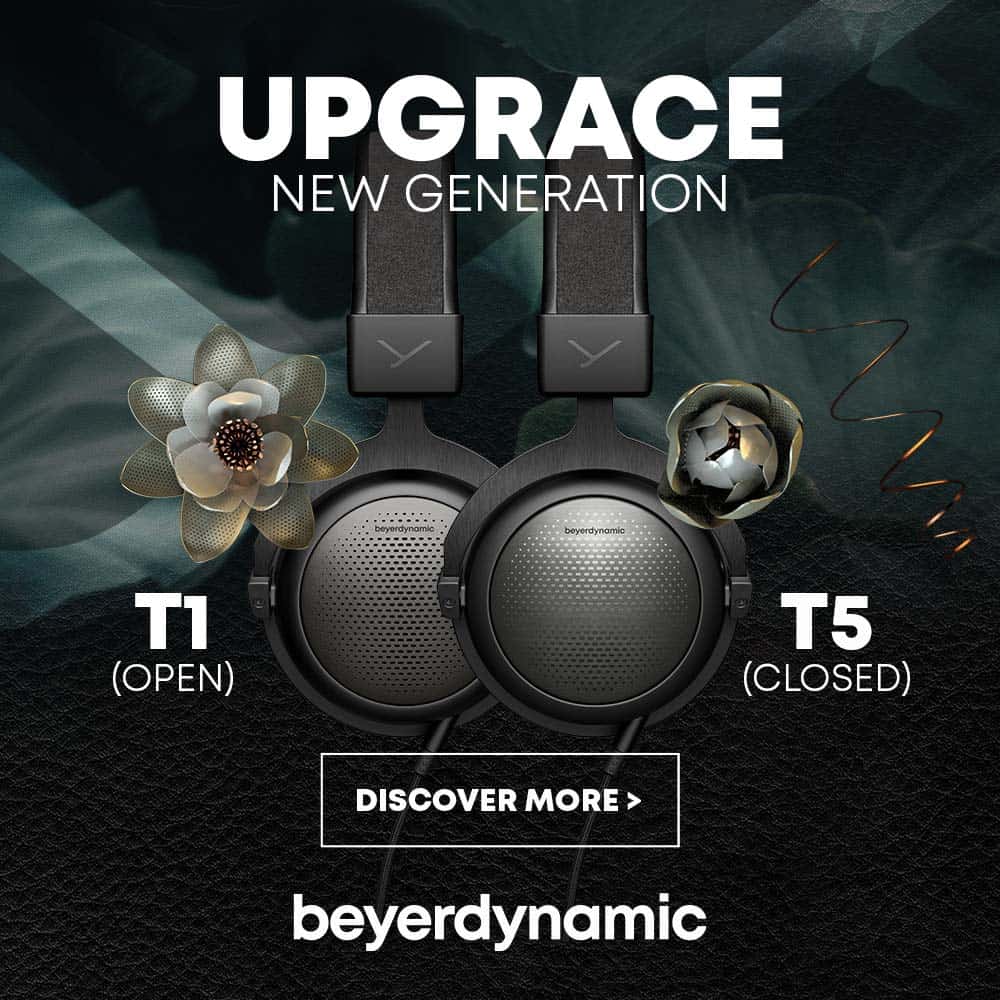iFi has been on a roll lately with some amazing audio products. They’ve cornered the market in well built, portable DACs and headphone amplifiers. And now they’re taking aim at home audio with desktop amplifiers. But what makes the iFi Retro Stereo 50 different from other desktop amplifiers on the market? Let’s take an in depth look and find out.
iFi Retro Stereo 50 Review
IN THE BOX
Opening up this carefully wrapped package you’ll feel like a kid in a candy store. After getting out the amplifier I noticed something that has become the signature of iFi products. I’ve got everything I need to get this amplifier running right now. Everything from cables to tools are included with the iFi. This is such an important thing and a lot of companies don’t do it. Nobody wants to buy a nice piece of audio equipment and then have to run out and buy a bunch of cables. iFi has it all in the box so you can play music right away.
Here’s a full list of what you’ll get in the box with the iFi Retro Stereo 50 Amplifier:
- iFi Retro Stereo 50
- 1 x Stereo RCA to RCA cable
- 1 x Stereo 3.5mm to 3.5mm cable (1/8″ to 1/8″)
- 1 x USB to digital cable
- 2 x speaker cables
- 4 x EL84X tubes
- 2 x ECF82 tubes
- 1 x optical to SPDIF digital adapter
- 1 x 3.5mm (1.8″) to 6.3mm (1/4″) adapter
- Gloves for installing the tubes
- Tool for opening the case
- Remote volume control
TUBE INSTALLATION
Installing the tubes might sound like a daunting task but it’s really not that difficult. Tubes are fragile so they need to be shipped separately from the unit. Popping them on the board is simple. Just open the top grill and use the provided gloves to place the tubes into the pin slots on the board. Everything is labeled so there’s no guessing. The gloves are simply there to keep hand oils off the tubes and it also keeps static from traveling into the tube when it comes into contact with the board.
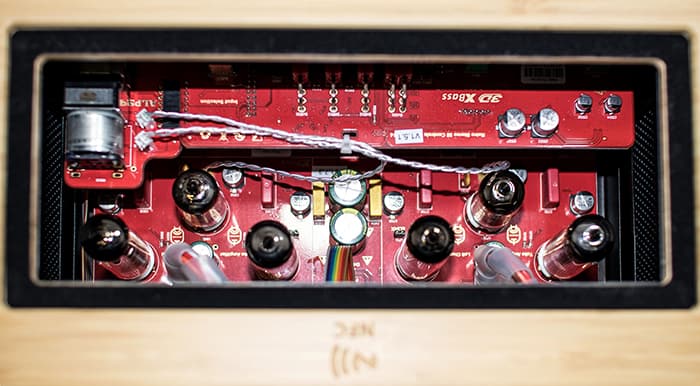
CONSTRUCTION
The iFi Retro Stereo 50 is a tough little unit. The wood casing is what gives it that retro feel and it visually warms up the typically cold look of stereo equipment. The components and materials used in the build of this small but powerful amplifier were chosen because of their durability. This is another signature trait of iFi amplifiers and it’s one that makes a huge difference. The Retro Stereo 50 feels just like those classic amplifiers with the big solid knobs that moved slowly and accurately. It reminds me a bit of the Sansui receiver I used to own. Overall, the iFi Retro feels like the kind of amp that you’ll have for a lifetime.
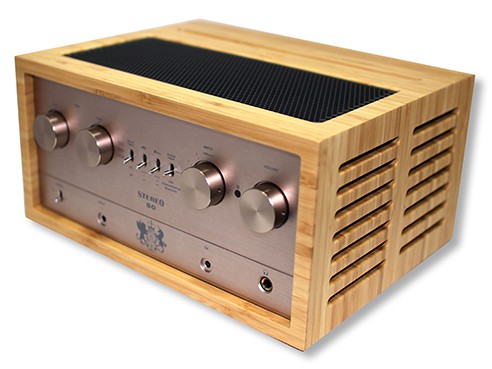
FEATURES
When it comes to features iFi has its’ finger on the pulse of what audiophiles want today and the Retro Stereo 50 is packed with exactly what you want. Turntable RCA inputs, digital inputs, a CD player or Aux RCA input, a 3.5mm stereo input and even Bluetooth & NFS connectivity for streaming music from your computer or mobile device! Plus there’s to types of headphone outputs on the front and even speaker connections on the back. The iFi Retro Stereo 50 tube amplifier has everything you can think of in terms of inputs, outputs and power.
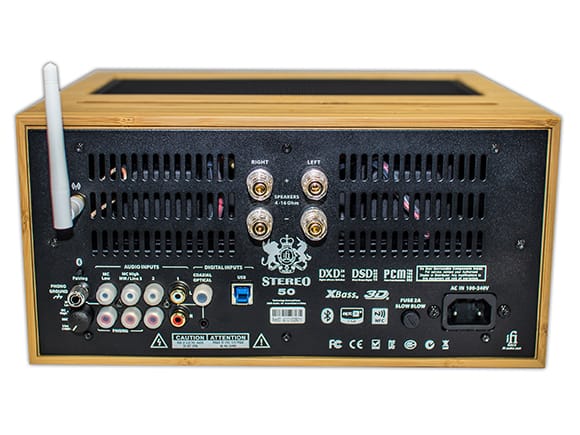
The digital inputs use Burr-Brown DAC chip developed by Texas Instruments. But they didn’t stop there. iFi then used AMR trickle-down technology to drive the Burr-Brown for the best output possible.
And then there’s the digital formats. The iFi Retro Stereo 50 can handle nearly any type of digital audio. It plays PCM audio up to 32/768kHz, DSD audio up to Octa-DSD512 and DXD up to 768kHz.
The tubes used in the iFi Retro Stereo 50 are the icing on the cake of this audiophile dream package. There’s a total of 6 tubes in the Retro Stereo 50 amplifier. You’ll find 4 of the EL84x tubes and 2 of the ECF82 tubes. Combined with the AMR DP-777 digital processor, these tubes make an unreal combination of digital audio and warm tube technology.
As with many of the iFi amplifiers, they’ve included their custom Xbass and 3D Holographic controls for an enhanced listening experience. Plus they’ve included 6 different EQ settings for vinyl lovers. Named after the record labels that made the music famous, the EMI, Columbia and Decca settings enhance the frequencies that sweeten the sound. Plus there’s CIRR/Teldec, DMM and RIAA modes.
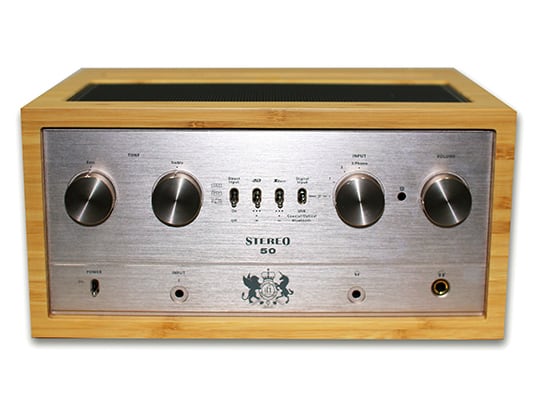
SOUND
Sound Signature
The iFi Retro Stereo 50 is an amp designed to be used in many different situations. With a digital input as well as as turntable, analog and Bluetooth input you’re able to get a wide range in sound quality. That being said, the sound of the Retro Stereo 50 sounds incredible.
I tested the analog, digital and Bluetooth inputs and got exciting results. The overall sound is big and well rounded. This compact amplifier packs a big punch in the bass and has complete flexibility in adding more or less bass depending on your listening preferences. You’ll never complain about not having enough bass options ever again.
The mids and high frequencies do get rounded out a bit running through the tubes but this is where you discover the big deal about tube amps. That slightly rounded sound signature will warm up the harshest of digital recordings and add sonic flavor to analog recordings. And that’s not to say the mids and highs are lacking. In fact these frequencies become even more pleasant after running through the Retro Stereo 50. And the weighty treble knob will give you a little extra high end if you feel like you’re missing out.
Headphone Amplification
The Retro Stereo 50 is both a headphone amplifier and speaker amplifier. Using it with headphones I found there wasn’t anything this tough amplifier couldn’t handle. From the 38 Ohm Audio Technica M50x to the 250 Ohm Beyerdynamic DT880, the iFi Retro 50 drove them with ease. It’s safe to say that whatever your headphone of choice is you’ll find a warm amplifier friend with the iFi Retro Stereo 50.
Speaker Amplification
At the moment I don’t have access to proper speakers for this iFi amplifier. I’m willing to bet that the speaker output is equally as powerful and sweet sounding as it is with headphones. I’ll update you once I get the chance to properly give this a speaker test.
SUMMARY
It may sound crazy but this is exactly what hardcore music listeners have been wanting. From everyday music lovers to audiophiles, the iFi Retro Stereo 50 is well equipped to please everyone with its ample features and phenomenal sound. If you’re in the market for a new home stereo and headphone amplifier, you’re search is over. Some people would prefer to hunt around and find one of those vintage stereo systems with the sweet sound. They’re also becoming rare and difficult to fix. The iFi Retro Stereo 50 is a brand new system with features no vintage stereo will have.
The bottom line is the iFi Retro Stereo 50 is a compelling and powerful headphone and speaker amplifier. It’s perfect for private listening sessions or entertaining guests at home. The price point is amazing at under $1500 which makes the iFi Retro Stereo 50 the only tube amplifier you’ll ever need.
You can pick one up from the iFi DAC and Amp Store at AUDIO46
SPECIFICATIONS
Wireless Input
Bluetooth (aptX) 1
Digital Input
USB (DSD512/768kHz/2xDXD) 1
Coaxial (192kHz) 1
Optical (192kHz) 1
Analogue Input
Phono(MM/MC Low/MC High/Line 3) 1
Line 1 1
Line 2 1
3.5mm (share with Line 2) 1
Outputs
Loudspeaker Output 1
3.5mm Headphone Output 1 (Output impedance 3.5mm < 3 Ohm)
6.3mm Headphone Output 1 (Output impedance 6.3mm < 6 Ohm) Audio Section Power output (Music) > 25W(majority Class A)
Total Harmonic Distortion(THD) < 0.2% (@ 2.83V/1W) Output bandwidth 10Hz ~ 60kHz Frequency Response 10Hz ~ 80kHz Signal-to-Noise Ratio > Amplifier 101dB (@ max output)
> Phono MM: 90dB(A)
> Phono MC: 80dB(A)
DAC Dynamic Range > 113dB(A)
Tone Control Bass(100Hz) +/-8dB
Treble(10KHz) +/-8dB
Analogue Signal Processing (ASP) XBass, 3D Holographic
Phono Gain 38, 50, 62dB
MM 220pF//47k
MC 200pF//330R
RIAA Accuracy <0.5dB
Tubes 2 x ECF82; 4 x EL84X
Digital Section
PCM 768/705.6/384/352.8/192/176.4/96/88.2/48/44.1kHz
DSD 512/256/128/64 24.6/22.6/12.4/11.2/6.2/5.6/3.1/2.8MHz
DXD 768/705.6/384/352.8kHz
Filters Minimum Phase (PCM 192/176.4/96/88.2/48/44.1kHz)
Bit Perfect (DXD/PCM 768/705.6/384/352.8)
Analogue (DSD)
General
Power Supply AC 100V-240V
Power consumption 75W
~0.1W (Standard mode)
Dimensions (W x H x D) 300 x 153 x 226mm
Weight 5.8kg
Compare the ranking of various headphones, earbuds and in-ear monitors using our tools.
Discuss this, and much more, over on our forum.
---MAJORHIFI may receive commissions from retail offers.





